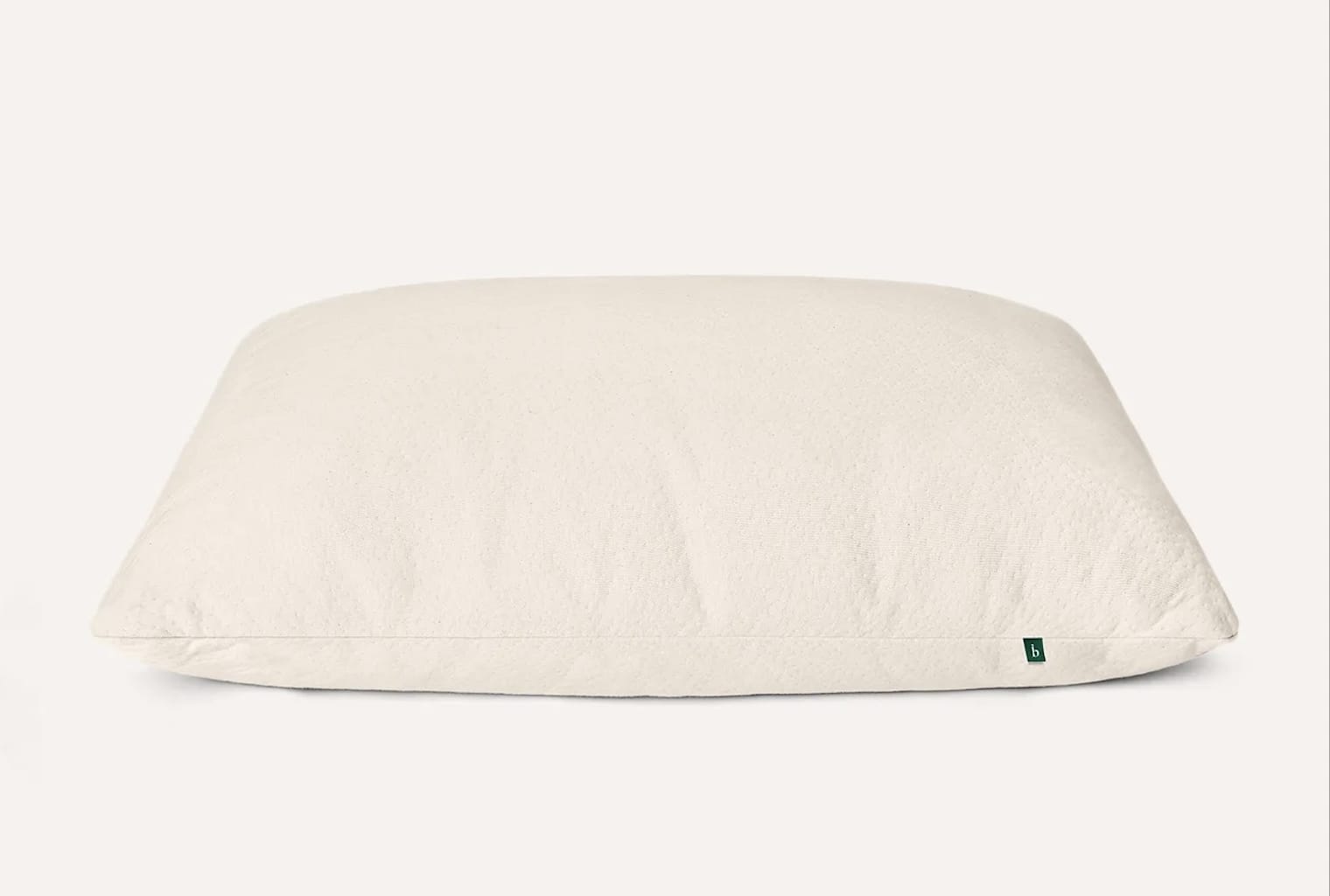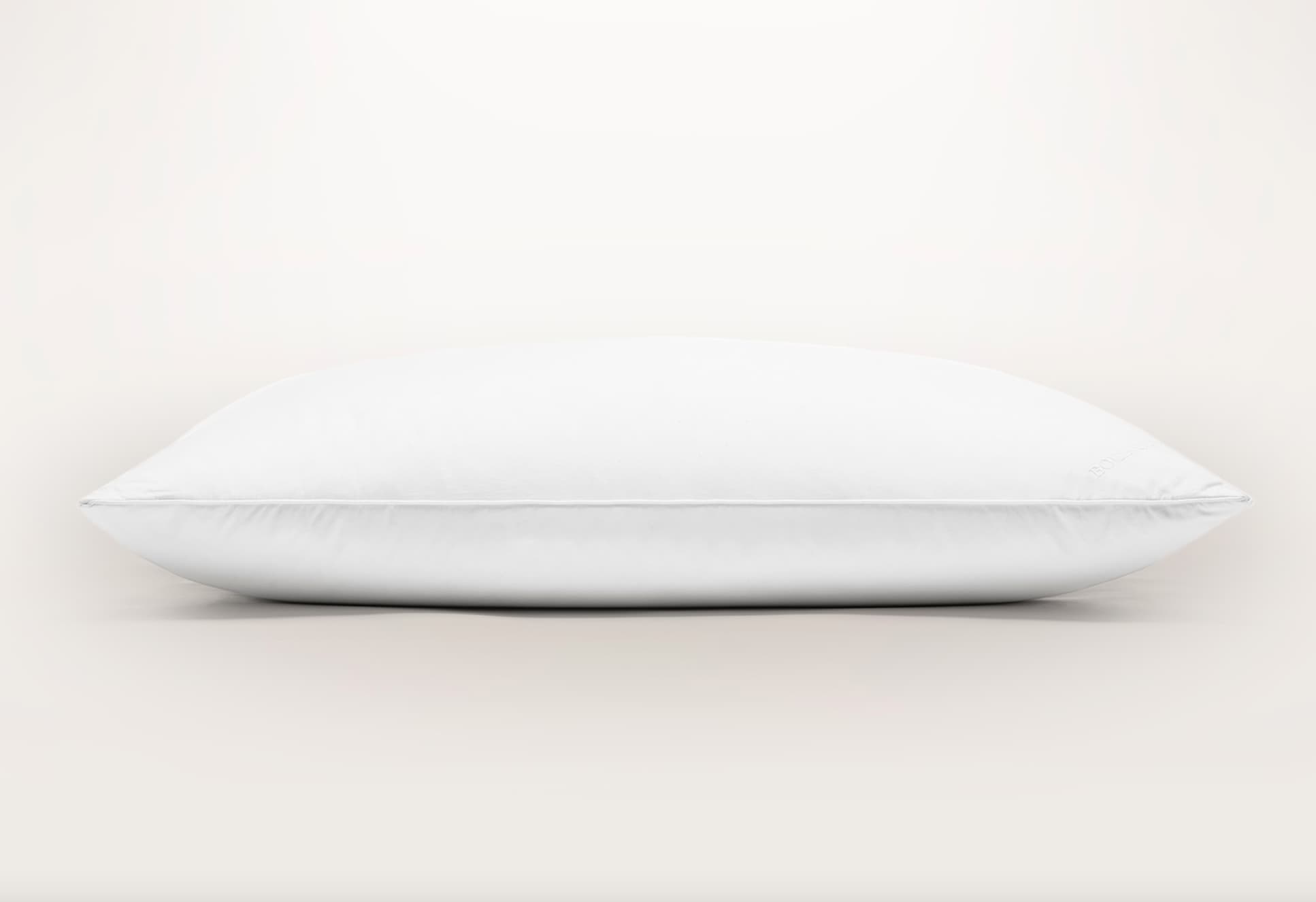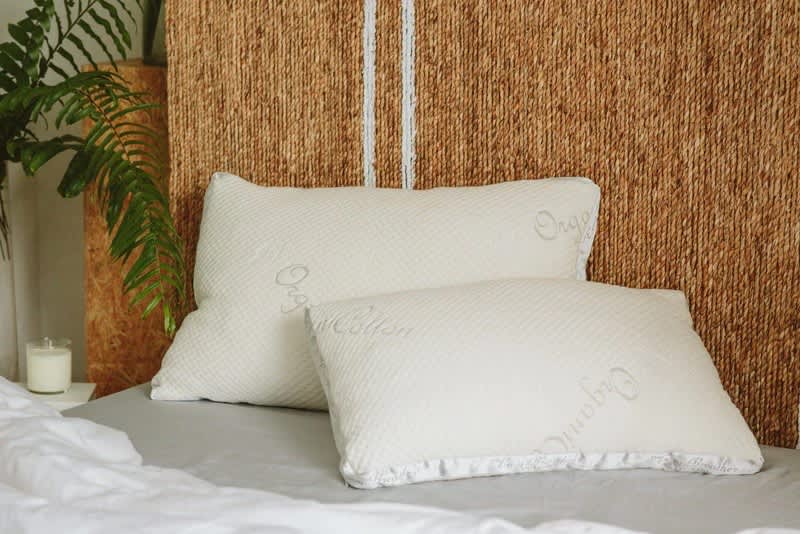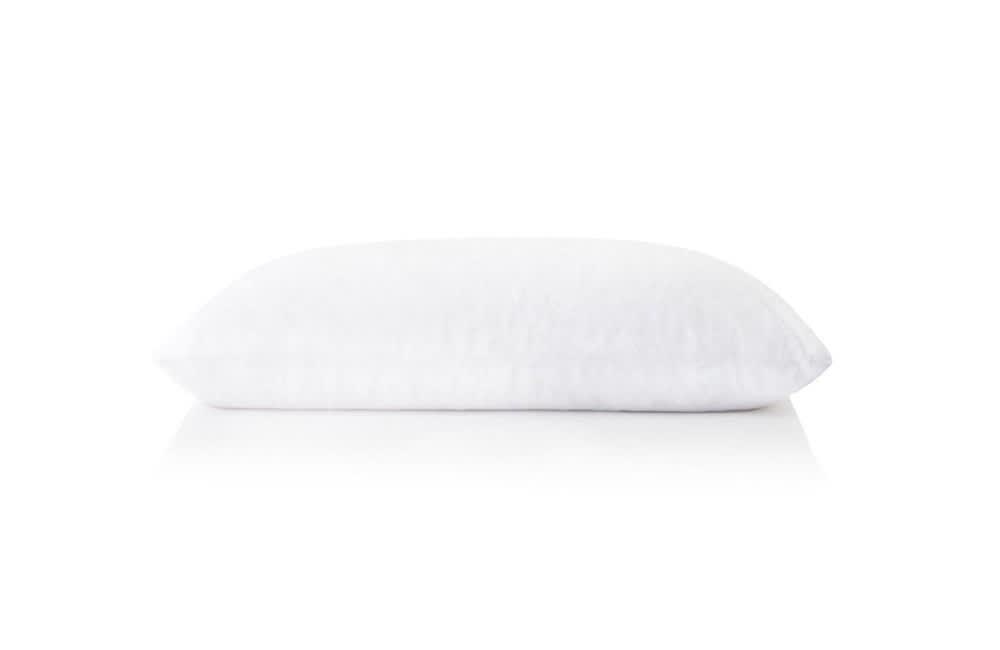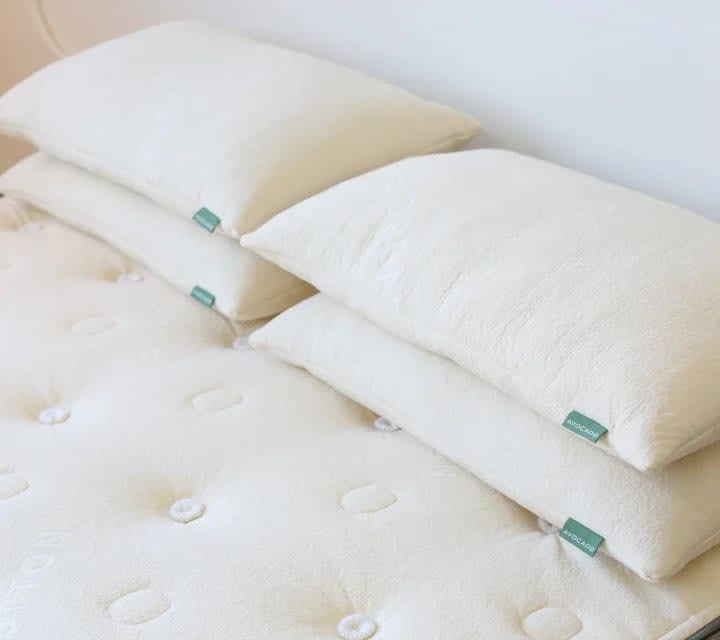On This Page
The Best Organic Pillows of 2025
Our Top Picks
-
Best Overall Pillow
Birch Organic Pillow -
Best Value Pillow
Boll & Branch Down Alternative Pillow -
Most Comfortable Pillow
Naturepedic 2-in-1 Adjustable Latex Pillow -
Best Luxury Pillow
Saatva Latex Pillow -
Best Pillow for Side Sleepers
Nest Bedding Easy Breather Natural Pillow -
Best Pillow for Neck Pain
PlushBeds Organic Shredded Latex Pillow -
Best Pillow for Pressure Relief
Avocado Green Pillow
Best Overall Pillow
Highlights
Highlights
- Holds several certifications related to contents and sustainability
- Shredded Talalay latex and organic wool for breathable plushness
- 100-night sleep trial
Ideal For
- Combination sleepers
- Eco-conscious shoppers
- Those who prefer a generous sleep trial
Full Details
Best Value Pillow
Highlights
Highlights
- Three firmness options available
- PrimaLoft down alternative imitates the lightweight fluffiness of down
- Machine-washable
Ideal For
- Shoppers looking for a specific firmness
- Sleepers who enjoy down-like plushness
- Those who like to launder their pillow
Full Details
Most Comfortable Pillow
Highlights
Highlights
- Holds multiple environmental and health-based certifications
- Adjustable fill allows sleepers to choose from multiple firmness levels
- One quilted and one flat side provide two different feels
Ideal For
- All sleeping positions, including combination sleepers
- Sleepers looking for breathable pressure relief
- Those with changing needs or preferences
Full Details
Best Luxury Pillow
Highlights
Highlights
- Adjustable pillow-in-pillow design
- Shredded Talalay latex core promotes shape retention
- Machine-washable cover
Ideal For
- Sleepers who enjoy a hotel-style pillow
- Those looking for adjustability without handling fill
- Side and back sleepers under 230 pounds
Full Details
Best Pillow for Side Sleepers
Highlights
Highlights
- Adjustable fill allows sleepers to modify the pillow’s loft and firmness
- Curved edge designed to accommodate a side sleeper’s shoulder
- Proprietary blend fill with shredded latex and polyester to mimic down
Ideal For
- Those who value durability
- Side sleepers of all body types
- Hot sleepers
Full Details
Best Pillow for Neck Pain
Highlights
Highlights
- GOLS-certified organic shredded latex fill for springy support
- Breathable GOTS-certified organic cotton cover
- Three-year limited warranty
Ideal For
- Combination sleepers
- Hot sleepers
- Eco-conscious shoppers
Full Details
Best Pillow for Pressure Relief
Highlights
Highlights
- Adjustable fill allows sleepers to fine-tune loft and firmness
- Combines GOLS-certified organic latex and GOTS-certified organic kapok
- Comes with extra fill
Ideal For
- Side and back sleepers
- Those who value durability
- Sleepers who prefer a highly conforming pillow
Full Details
How We Test Pillows
We test pillows against the same set of strict standards that we use for other pillow types, but we pay close attention to several factors that set different pillows apart. In addition to firmness, conforming, and ease of cleaning, we also measure breathability. Many sleepers choose specific materials for their cool feel. To determine how well a pillow regulates temperature, we use thermal sensors that measure heat retention and we try them ourselves too, taking notes on how warm or cool we think a pillow feels after use.
Why Choose an Organic Pillow?
Organic pillows provide several potential advantages over non-organic pillows, making them an attractive option. Organic pillows are typically more environmentally and socially sustainable. Additionally, they tend to use high-quality materials that increase their life expectancy, improve air circulation, and lessen the likelihood of irritation. Many are also hypoallergenic. Since organic pillows reduce exposure to chemicals, shoppers often see them as a healthier option.
We’ll explore the difference between organic and non-organic models to help you pick the right pillow for you.
What Is an Organic Pillow?
An organic pillow may contain any number of organic materials, such as cotton, latex, wool, buckwheat, or kapok. Organic farming aims to reduce negative impacts on humans, animals, and the environment by limiting the use of potential toxins, reducing water usage, and preventing soil erosion. To that end, the production process for organic pillows also frequently eliminates the use of bleach, chemical dyes or fire retardants, and formaldehyde.
The government and third-party organizations offer several certifications to ensure consumers can easily identify which materials are truly organic. Common organic certifications for pillow materials include USDA Organic, Global Organic Latex Standard (GOLS), and Global Organic Textile Standard (GOTS). We’ll discuss these certifications in more detail so consumers are better prepared when choosing organic pillows.
Because of their high-quality natural materials, organic pillows are often hypoallergenic and excel in temperature regulation and durability.
There are a lot of sleep products out there claiming to be organic. You can make sure you’re getting the real thing by looking for third-party certifications and transparent manufacturing practices. .
Are Non-Organic Pillows Toxic?
Some non-organic pillows may contain potentially harmful substances.
Non-organic materials are grown using conventional farming that often relies on chemical pesticides, fertilizers, and other substances intended to improve crop yield. Not only can chemical fertilizers and pesticides contaminate the environment, but they can also cause acute and chronic health effects ranging from rashes to cancer.
The manufacturing process also involves the use of potentially harmful chemicals. For instance, non-organic pillows typically contain flame retardants to slow potential fires. Although they are a safety measure, chemical flame retardants have also been linked to cancer and reproductive issues. Non-organic pillow manufacturing also frequently produces volatile organic compounds. You can reduce exposure by letting your new pillow air out in a well-ventilated space. Common signs of excessive exposure include headache and irritation of the eyes, nose, or throat.
Keep in mind that product regulations vary by country. Pillows manufactured abroad may not comply with U.S. regulations, though a U.S. company outsourcing the manufacturing is expected to communicate relevant standards.
For additional reassurance that you’re limiting your exposure to potentially harmful substances, look for relevant third-party certifications. OEKO-TEX Standard 100, GREENGUARD Gold, and eco-INSTITUT are popular health-based certifications. For pillows that contain synthetic foam, you might also look for CertiPUR-US certification.
Common Types of Organic Pillows
As eco-friendly and sustainable products grow in popularity, the demand for organic pillows also increases. To meet this demand, pillow manufacturers are crafting more and more organic pillows. This has also led to more types of pillows available on the market, ranging from cotton to buckwheat.
Organic Cotton
Organic cotton is a soft plant-based fiber that can be woven into a pillow cover or stuffed into the pillow as a fill. While firmness varies depending on the construction, many pillows with cotton fill have a slightly firmer feel. At first, they may appear fluffy, but they often clump or flatten over time. Cotton is highly breathable, making cotton pillows a popular choice for hot sleepers.
Non-organic cotton requires intense water irrigation and pesticide use, which often contaminates local waterways. Organic cotton uses environmentally friendly alternatives, reducing the environmental impact. USDA Organic certification verifies that cotton was grown in accordance with organic standards, whereas GOTS certification attests to sustainable practices from cultivation through manufacturing.
Organic Latex
Natural latex uses the sap of rubber trees, resulting in a responsive, breathable, and contouring material. Pillow fill may include a solid piece of latex or shredded latex. Solid latex is usually more supportive, while shredded latex tends to be more moldable. Generally, latex pillows have a longer-than-average lifespan thanks to the material’s natural durability.
There are two types of natural latex production processes. Talalay latex uses a more complex manufacturing process, resulting in a lighter material that does not meet strict organic requirements. Dunlop latex utilizes a simpler, more efficient manufacturing process that produces a firmer, more durable material. GOLS organic certification verifies the rubber is grown on certified organic plantations, has a traceable supply chain, and meets limits for emissions, fillers, and harmful substances.
Organic Wool
Typically derived from sheep, organic wool has a soft yet supportive feel. Wool may appear in the pillow’s cover or fill. In either place, wool’s exceptional moisture-wicking and temperature regulation help promote all-season comfort. We often find that pillows with wool fill are firmer, but they tend to lump or go flat.
For wool to be certified as organic, it must come from animals raised in accordance with USDA Organic livestock standards. Producers cannot use prohibited feed ingredients, added growth hormones, or genetic engineering. They must also ensure livestock have year-round access to the outdoors and implement preventative disease management practices. GOTS certification verifies that the processing of organic raw wool also meets organic standards related to dyes, treatments, and water discharge.
Kapok
Kapok is a light and fluffy fiber that comes from kapok trees native to tropical rainforests. The fiber is silkier and lighter than cotton, making it a popular natural option for pillow fill. Because it’s similar to down in its lightness and plushness, pillows with kapok fill compress easily under a sleeper’s head.
Kapok is one of the most sustainable fibers on the market, requiring minimal intervention and irrigation. The fibers naturally grow without chemical fertilizers or pesticides. GOTS certification verifies kapok fiber meets ecological and social standards.
Buckwheat
A buckwheat hull is the outer shell of a buckwheat seed, meaning the resulting pillow fill is firm and supportive but conforms to your head, neck, and shoulders. Buckwheat pillows are known for providing pressure relief, support, and air circulation. They’re also typically durable and adjustable.
Organic buckwheat naturally grows quickly, with plants maturing 10 to 12 weeks after planting. Buckwheat’s large leaves also stop sunlight from reaching the surrounding soil, preventing weed growth. Organic buckwheat hulls can hold GOTS or USDA certification.
Responsible Down
Sourced from the underbelly of waterfowl, such as ducks or geese, down feathers are delicate and silky to the touch. High-quality down fill contributes to a soft and lightweight pillow. While down pillows are fluffy and moldable, they often go flat overnight.
While down doesn’t typically hold organic certification, Responsible Down Standard certification can provide some reassurance about production methods. The Responsible Down Standard promotes the humane treatment of animals.
Since latex, down, wool, cotton, buckwheat, kapok, and other fill materials can all be organic, you’ll need to figure out how to choose between them. Think about whether you want a material that’s easy to mold, then pick a loft and firmness level. .
What Is the Best Organic Pillow for You?
The best organic pillow varies between individuals. Each person has their own specific needs depending on their body type, sleeping position, and preferences. The right balance of support and softness is essential to maintaining spinal alignment, but other factors also influence comfort and overall satisfaction.
Organic Certifications
When searching for the right organic pillow, check for organic certifications. This ensures the pillow has met specified criteria and regulations outlined by a governing body, whether that be the government or a third-party organization. The most common organic certifications to look for include GOTS and GOLS.
Some companies advertise pillows as organic without noting relevant certifications. If you’re interested in such a product, you may want to reach out to the manufacturer to inquire about certifications. In some cases, companies simply don’t use their certification status for marketing. In other instances, the manufacturer has chosen to forgo the certification process or the product does not meet the certification standards.
Loft and Firmness
Every sleeping position requires a different loft and firmness level to promote proper spinal alignment. The optimal pillow loft should fill the space between the sleeper’s head and the mattress while supporting the natural curvature of the neck. Ideal firmness depends on the level of support you need to maintain good posture. Some sleepers need more consistent lift, while others need to sink in.
Pressure Relief
Pillows provide pressure relief by alleviating pressure buildup at contact points and supporting the neck to minimize tension. Pillows that excel in our conforming tests usually offer superior pressure relief, adjusting to different sleeping positions and body types. Common pressure-relieving natural materials include latex, buckwheat hulls, and kapok fibers.
Shape and Moldability
Although most pillows are rectangular, alternative designs address specific sleeper needs. For instance, contour pillows have a curved design intended to promote spinal alignment and alleviate pressure. Latex is often the material of choice for pillows with distinct shapes due to its responsiveness and durability.
While a specific shape may appeal to some sleepers, others prefer traditional pillows that are easily moldable to their sleeping position. Materials like cotton and kapok are easy to squish and manipulate to accommodate your current needs and preferences. Since latex tends to hold its shape, it’s usually less moldable.
Temperature Regulation
Those who tend to sleep hot should look for a pillow that regulates temperatures and disperses heat. Organic pillows contain breathable materials, such as cotton, kapok, latex, or buckwheat hulls, which enables ample airflow to keep the surface cool.
How to Tell if Your Pillow Is Really Organic
Identifying a true organic pillow isn’t always easy. Not every brand is forthcoming about its materials, manufacturing, and production. If the pillow is produced outside of the U.S., determining whether it’s organic becomes that much more complicated. The easiest way to verify whether a pillow is really organic is through certification. We’ll explore common certifications and what they indicate.
Organic, Natural, Eco-Friendly, and Green – Are They All the Same?
As the organic pillow industry grows, many retailers are jumping on the bandwagon by referring to their products as organic, natural, eco-friendly, or green. While these terms are closely related, they often refer to different things. For instance, a fully synthetic pillow could be described as eco-friendly if the manufacturer uses more sustainable production techniques. Looking for relevant certifications is often the only way to verify these marketing claims.
Organic Certifications
The organic pillow industry commonly uses several standards related to product contents and sustainability. A company must follow a predetermined set of rules and regulations to achieve certification. Frequently, certification also requires third-party testing for verification.
Global Organic Textile Standard (GOTS)
GOTS is a third-party organization founded by the Organic Trade Association (OTA), the International Association of Natural Textile Industry (IVN), the Soil Association (SA), and the Japan Organic Cotton Association (JOCA) to set international standards for the organic textile industry. GOTS textiles contain 70% certified organic fibers, and those with an organic GOTS label have 95% certified organic fibers.
Global Organic Latex Standard (GOLS)
The Control Union, an organization focused on developing sustainability certifications for the agriculture industry, introduced GOLS to verify organically grown natural rubber latex. A GOLS certification ensures the product limits harmful substances and passes emission tests.
OEKO-TEX Standard 100
OEKO-TEX, an independent research and testing organization for the textile industry, created the Standard 100 certification. The label tells consumers that a product is free of many harmful substances, both regulated and non-regulated. OEKO-TEX can test several aspects of a product, including the fabric, coating, stitching, and zipper.
Eco-INSTITUT
Awarded by a German-based organization of the same name, the eco-INSTITUT label verifies that a product has been tested for emissions and pollutants.
GREENGUARD
Provided by UL Solutions, a safety science company, GREENGuard certification ensures a product’s compliance with chemical emissions standards. UL Solutions also offers a GREENGUARD Gold certification, which has more stringent requirements.
USDA Organic
A USDA Organic certification applies to crops and livestock, verifying they were cultivated in accordance with set organic standards. These standards include the prohibition of genetic engineering, the responsible management of biodiversity, and more.
Explore More Pillows
If you’re looking for a particular type of pillow, check out our other guides below.
